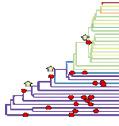当前位置:
X-MOL 学术
›
J. Integr. Plant Biol.
›
论文详情
Our official English website, www.x-mol.net, welcomes your feedback! (Note: you will need to create a separate account there.)
Recurrent genome duplication events likely contributed to both the ancient and recent rise of ferns.
Journal of Integrative Plant Biology ( IF 11.4 ) Pub Date : 2019-12-30 , DOI: 10.1111/jipb.12877 Chien-Hsun Huang 1 , Xinping Qi 1 , Duoyuan Chen 1 , Ji Qi 1 , Hong Ma 2
Journal of Integrative Plant Biology ( IF 11.4 ) Pub Date : 2019-12-30 , DOI: 10.1111/jipb.12877 Chien-Hsun Huang 1 , Xinping Qi 1 , Duoyuan Chen 1 , Ji Qi 1 , Hong Ma 2
Affiliation

|
Ferns, the second largest group of vascular plants, originated ~400 million years ago (Mya). They became dominant in the ancient Earth landscape before the angiosperms and are still important in current ecosystems. Many ferns have exceptionally high chromosome numbers, possibly resulting from whole‐genome duplications (WGDs). However, WGDs have not been investigated molecularly across fern diversity. Here we detected and dated fern WGDs using a phylogenomic approach and by calculating synonymous substitution rates (Ks). We also investigated a possible correlation between proposed WGDs and shifts in species diversification rates. We identified 19 WGDs: three ancient events along the fern phylogenetic backbone that are shared by 66%–97% of extant ferns, with additional lineage‐specific WGDs for eight orders, providing strong evidence for recurring genome duplications across fern evolutionary history. We also observed similar Ks peak values for more than half of these WGDs, with multiple WGDs occurring close to the Cretaceous (~145–66 Mya). Despite the repeated WGD events, the biodiversity of ferns declined during the Cretaceous, implying that other factors probably contributed to the floristic turnover from ferns to angiosperms. This study provides molecular evidence for recurring WGDs in ferns and offers important clues to the genomic evolutionary history of ferns.
中文翻译:

反复发生的基因组复制事件可能促进了古老和最近的蕨类植物的崛起。
蕨类植物是第二大维管束植物,起源于大约4亿年前(Mya)。它们在被子植物之前的古代地球景观中占主导地位,并且在当前的生态系统中仍然很重要。许多蕨类植物具有异常高的染色体数,这可能是由于全基因组重复(WGD)造成的。但是,尚未对蕨类植物多样性进行分子生物学研究。在这里,我们使用植物学方法并通过计算同义替代率(Ks)来检测并标明了蕨类WGD。我们还研究了拟议的WGD与物种多样化率变化之间的可能相关性。我们确定了19种WGD:在蕨类系统发生主干线上的3个古代事件,由现存蕨类的66%–97%所共有,另外还有8个订单的特定于世系的WGD,为跨蕨类进化史的基因组重复性复制提供了有力的证据。我们还观察到超过一半的这些WGD的Ks峰值相似,多个WGD发生在白垩纪附近(〜145-66 Mya)。尽管发生了重复的WGD事件,但白垩纪时期蕨类植物的生物多样性却下降了,这暗示着其他因素可能导致了蕨类植物到被子植物的植物更新。这项研究为蕨类植物中WGD的复发提供了分子证据,并为蕨类植物的基因组进化史提供了重要线索。暗示其他因素可能有助于从蕨类植物到被子植物的植物更新。这项研究为蕨类植物中WGD的复发提供了分子证据,并为蕨类植物的基因组进化史提供了重要线索。暗示其他因素可能导致了从蕨类植物到被子植物的植物更新。这项研究为蕨类植物中WGD的复发提供了分子证据,并为蕨类植物的基因组进化史提供了重要线索。
更新日期:2019-12-30
中文翻译:

反复发生的基因组复制事件可能促进了古老和最近的蕨类植物的崛起。
蕨类植物是第二大维管束植物,起源于大约4亿年前(Mya)。它们在被子植物之前的古代地球景观中占主导地位,并且在当前的生态系统中仍然很重要。许多蕨类植物具有异常高的染色体数,这可能是由于全基因组重复(WGD)造成的。但是,尚未对蕨类植物多样性进行分子生物学研究。在这里,我们使用植物学方法并通过计算同义替代率(Ks)来检测并标明了蕨类WGD。我们还研究了拟议的WGD与物种多样化率变化之间的可能相关性。我们确定了19种WGD:在蕨类系统发生主干线上的3个古代事件,由现存蕨类的66%–97%所共有,另外还有8个订单的特定于世系的WGD,为跨蕨类进化史的基因组重复性复制提供了有力的证据。我们还观察到超过一半的这些WGD的Ks峰值相似,多个WGD发生在白垩纪附近(〜145-66 Mya)。尽管发生了重复的WGD事件,但白垩纪时期蕨类植物的生物多样性却下降了,这暗示着其他因素可能导致了蕨类植物到被子植物的植物更新。这项研究为蕨类植物中WGD的复发提供了分子证据,并为蕨类植物的基因组进化史提供了重要线索。暗示其他因素可能有助于从蕨类植物到被子植物的植物更新。这项研究为蕨类植物中WGD的复发提供了分子证据,并为蕨类植物的基因组进化史提供了重要线索。暗示其他因素可能导致了从蕨类植物到被子植物的植物更新。这项研究为蕨类植物中WGD的复发提供了分子证据,并为蕨类植物的基因组进化史提供了重要线索。



























 京公网安备 11010802027423号
京公网安备 11010802027423号